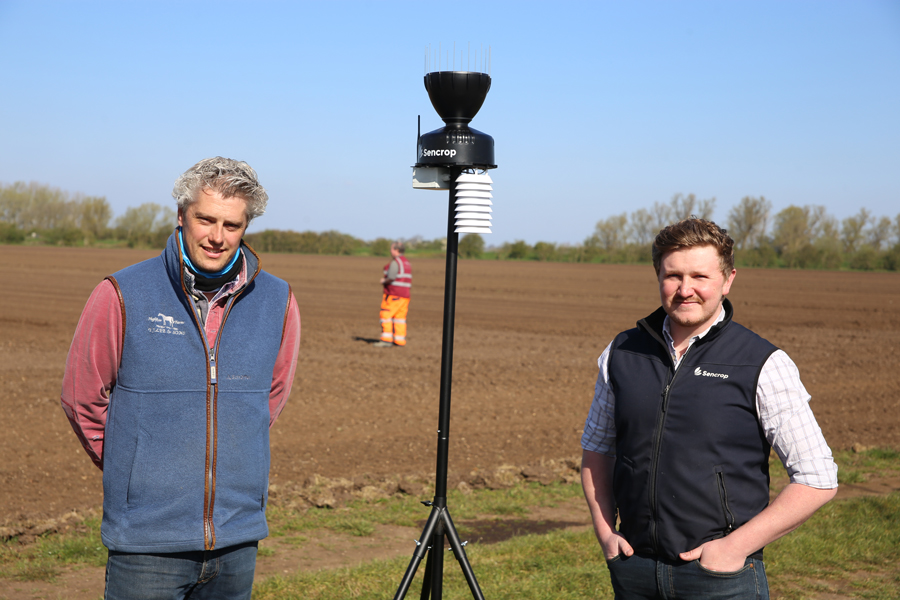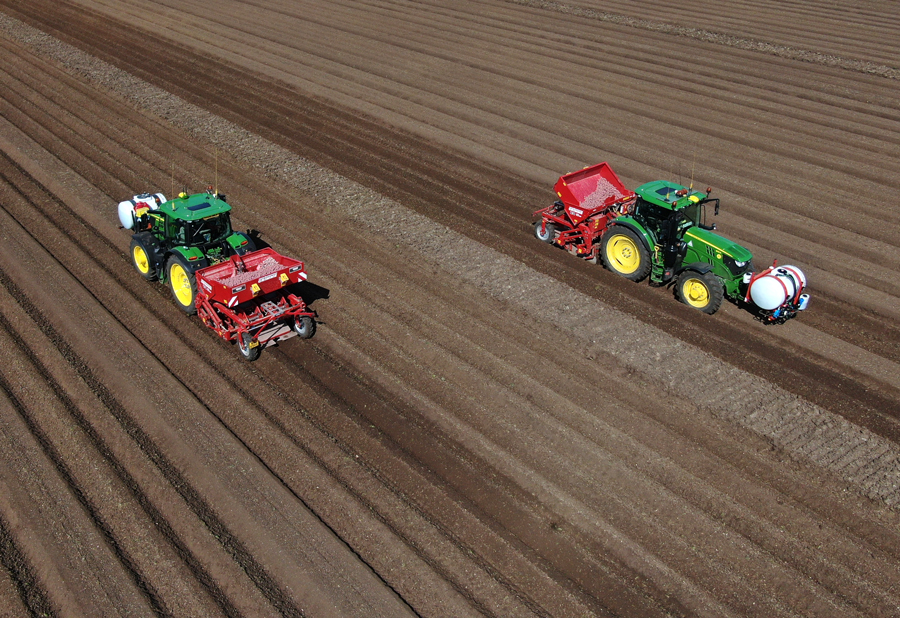Time and cost savings from weather station investment
5th May 2021
A network of Sencrop connected weather stations is helping save time and costs for one of the UK’s biggest independent potato producers. David Williams reports.
PJ Lee & Sons Ltd farms more than 5,100ha of arable crops within a 35- mile radius of its base at Sutton Gault, near Ely, Cambridgeshire. Also trading as Highflyer Farms, the Lee family grows cereals, sugar beet, vegetables and root crops, but late-harvested potatoes grown for the fresh chipping market are their flagship crop. The potatoes are grown on owned and rented land and a team of 38 full-time and 115 seasonal staff are employed.
The operation is managed by business directors Richard Lee and his sons Andrew and Christopher who are the third generation of the Lee family to be involved with the business.
High cost
“In the past, our estate manager Simon Quince left home at 3.30am to check 20–25 rain gauges before arriving at Sutton Gault, so decisions could be made regarding the day’s activities,” explained Andrew Lee. “This was mainly for operations including irrigation, planting and harvesting, but then if it rained again in the morning then the gauges were all re-checked at lunchtime. Even though we are based in the Fens and it’s fairly flat there are very big differences in rainfall between areas. The rain gauges were accurate but labour intensive, and with Simon and me both travelling to check them twice a day and using two vehicles to do it, the cost was approximately £800.”
Sencrop business development manager Harry Atkinson knows the Lee family well and he suggested that a network of connected weather stations might save the business time and money. Providing accurate weather information accessible from anywhere through a smartphone app, investing in a network would reduce travel between sites to check conditions and would also allow comparison of conditions at various locations in real-time.
User-friendly
Eleven Sencrop Raincrop rain gauges were installed during 2020 to measure humidity, followed by a further nine so far this year. Two Sencrop Windcrops were also installed measuring wind strength and direction, and two Leafcrop leaf monitors were also added to the network. Real-time data from these is sent automatically through the Sigfox network to
Sencrop’s servers and can be accessed by authorised users through Sencrop’s smartphone app. “Often we have found that technical systems intended to improve efficiency actually hinder the operation when they aren’t user-friendly, but the Sencrop app is very easy to use and there is no logging in and out once it is set up.
We just click on the app and the data is available and we can easily select any of the weather stations on our network from the map and then see what the weather is doing there.
We can also view historical records including rainfall and temperatures and make fact-based judgements on whether field work at the location will be possible. It couldn’t be easier to use and instead of getting up early to check rain gauges a long distance away we now obtain the same information before leaving home.”
Surprising variations
Previously, temperature information was based on conditions at the main base but since having the Sencrop network the team’s thought process has changed as the weather stations have revealed greater variations than expected. “We used to assume that the lowest points were coldest, so we started field activities on higher ground and then worked towards the lowest,” Andrew explained. “We have land at Holme Fen which is well below sea level and one of the lowest locations in the country and we had always assumed this would be our coldest area, whereas we now know that the average temperature there is warmer than at many of our other sites.”
Harry Atkinson agrees. “We often find that when growers install the Sencrop connected network and are able to accurately compare climatic data then there are variations which surprise them. Physiological features such as rivers have quite an effect on temperatures and rainfall and often one side of a river will be colder or wetter than the other and when this information is known then it can be included in decision making.”
Extra benefits
Andrew said that as the team combines practical experience with data from the weather stations the information becomes more useful.
“If we needed to spray in the past but suspected conditions might be too wet, then we used to travel to the field and see how the sprayer travelled. We have since ascertained that the ‘limit’ is 2mm of rainfall, so we now check the app and if we have had more than 2mm we know it’s not worth filling the sprayer. Similar rules apply for cultivations.”
Accurate records
Information from the weather stations is stored by Sencrop and available for recall at any time by the users. Although the Lees make more use of real-time weather information currently, Andrew suggested that as historical data builds up it will become a useful reference.
Temperature records are expected to be particularly interesting as these give an indication of how quickly the soil warmed up in the spring.
“Rainfall data is already useful and we have kept written records for many years. We use historical information when trying to work out why water logging has occurred for example – if the rainfall has been especially high then that might explain the issue, but if rainfall has been low or only average then we might need to check the drains and ditches, or consider investing in extra drainage.”
Andrew believes that having the Sencrop network will also offer benefits if water extraction regulations are tightened in future.
“We only irrigate when extra water is required by the crop and then only as much as is needed.
“Combining irrigation records with rainfall and humidity data from the weather stations means that if we are ever asked to demonstrate careful use, then we have the data to justify our decisions.”

Pictured with one of their 20 Sencrop Raincrop weather stations is Andrew Lee (left) with Sencrop business development manager Harry Atkinson.
Understanding blight
Leaf sensors were added to the Lee’s system to improve targeting of blight when pressure is high. “By mapping factors including temperature, rainfall and humidity we can add this to data from the leaf sensors to improve our understanding of what is happening with the leaves including how quickly they dry out after irrigation, rain or heavy dew and target our blight sprays more effectively.”
Used in stores too
The Sencrop weather stations are easily moved between sites making them ideal for growers using rented land. However, the Lees also use them to monitor conditions in potato stores.
“During winter we don’t need them in the fields, and although our own stores are equipped with monitoring equipment to ensure conditions remain optimal, we also rent other stores some of which don’t have the same facilities. We place the Raincrop stations on the chitting trays and use them to monitor conditions including day-degrees for our seed.”
Professional growers
“We have seen a big increase in the number of professional growers subscribing to our service,” continued Harry. “One of the big attractions is that they can start with a basic package and then add extra sensors and stations very easily and our flexible subscription options are great value for money.”
Andrew said that all members of the management team use the Sencrop system. “We look at information from our weather stations all the time, and an advantage of Sencrop’s connected system is its reliability, accuracy and that the whole concept is so simple and user-friendly. We saw immediate time and cost savings as soon as the stations were installed as we no longer travelled between sites checking and emptying rain gauges each day, and being able to check weather conditions in real-time at any of our locations in just a few seconds allows us to make fact-based decisions immediately rather than having to wait while someone travels to the fields to check.
“We do everything we can to produce top quality potatoes and optimise yields, and the Sencrop system helps us improve timeliness of operations and make best use of opportunities to work when conditions allow.”

